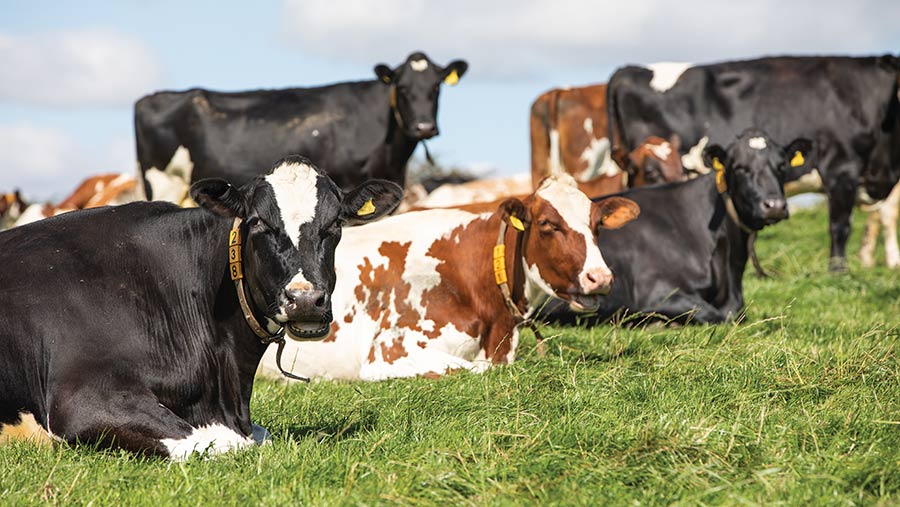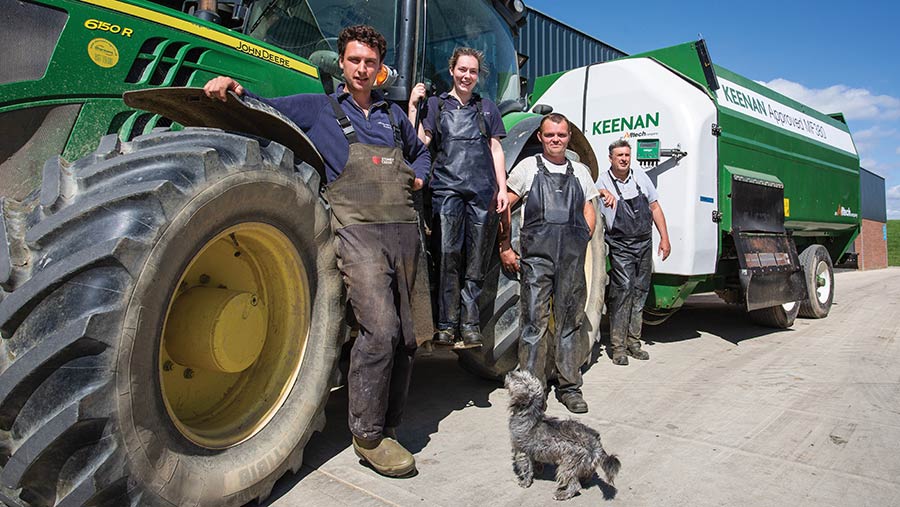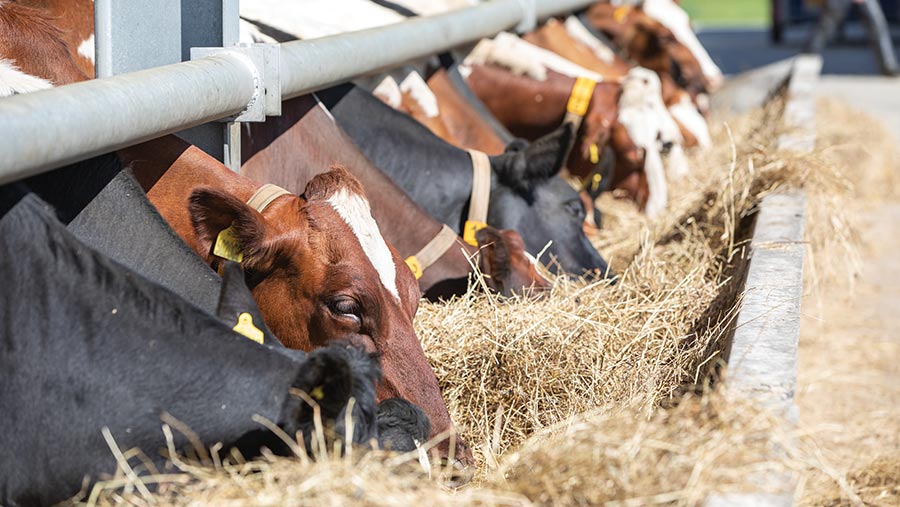How a greenfield dairy targets ‘resilient’ 50% yield lift
 © Way2Grow Marketing
© Way2Grow Marketing An autumn-calving herd is targeting 7,500 litres from 1.5t of parlour cake after moving farm, breed and system.
The Barnes family of Alma Bank Farm, near Oakham, have endured six tumultuous years since selling their old farm in nearby Somerby, with planning permission for housing, and building a greenfield dairy unit in the middle of their land.
Since switching from spring to autumn calving – while growing the herd from 150 to 290 cows, building a new unit and selling their old one – they have also been hit by two droughts, a two-year delay to building at Somerby, “B” prices for milk during Covid, a bovine TB breakdown and falling milk prices.
See also: How to budget for the switch to autumn calving
This made a hard job extremely difficult, says Mark Barnes, who farms with wife Jane, children Harry and Charlotte, full-time staff Florence Turley and Mark Hornby, and two part-time agriculture students.
Farm facts: Alma Bank Farm, Oakham
- 6,900 litres a cow a year at 4.2% fat and 3.4% protein
- 206ha, half owned and half rented on annual leases
- 97ha grazing platform
- Buys in 1,000t of contract-grown maize annually
- Supplies Long Clawson on cheese contract
- Four full-time labour units
- “Cow classroom” for showing the public how milk is produced

The team at Alma Bank Farm © Way2Grow Marketing
Farm move
Southfields Farm was outdated and, positioned in the centre of the village of Somerby, it was also hard to access.
So it was sold with planning permission for 10 houses to build a new farm fit for the future, which could eventually house 350 cows.
The sale raised half the money required to build Alma Bank Farm. That left the business with the other 50% to pay back. Land area was doubled through renting.
Farm move timeline
- 2016 Family decided to sell Southfields Farm, with planning for housing development, and relocate.
- 2017 Started building youngstock shed at Alma Bank Farm.
- 2018 Planning permission agreed at Southfields. Started building cubicle house and parlour at Alma Bank in February. Moved 150 spring calvers at the end of a dry summer and fed them with a forage box as there was very little grass. Bought 70 in-calf heifers to calve in the autumn.
- 2019 Delivery of gates and steel for the new shed delayed until January, so decrepit gates from Southfields used as makeshift barriers.
- 2021 Stopped serving the spring block. Autumn block calved from June to December.
- 2022 Autumn herd calved from August to November.
- 2023 Only 14 due to calve in November outside the 12-week block.

© Way2Grow Marketing
Resilience
Farming through challenging weather and market conditions with a two-year delay in the land sale was like “farming with your hand behind your back”, explains Harry, who was the fourth generation to farm at Southfields.
“It was a nightmare at times but forced us to scrutinise machinery costs and passenger cows.”
The 2022 drought added 5-6p/litre to bought-in feed costs and the TB breakdown lumbered the family with 100 beef calves and slowed the progress of the autumn-calving block.
“My dad said farming is about managing disappointment,” recalls Mark. “We need a system to cope with dry weather and lower milk prices.”
6 ways the Barnes hope to hit their target

© Way2Grow Marketing
1. Larger cow type
- Previously, the herd was a 540kg pedigree Ayrshire herd, averaging 5,000 litres from 1t of cake. Current average herd weight is 580kg. This may increase to 600-620kg, after crossing to British Friesian and low-stature Holstein for a higher output cow.
- Larger cows are already peaking at 30 litres and producing close to 7,500 litres a lactation, owing to more milk production later in the lactation. Average herd yield through the winter is 25 litres/day.
- Good fertility is essential for the farm to achieve a 12-week calving block.
- The farm is hilly and cows regularly walk 3-4km to the parlour and back daily, so good locomotion is key.
- Solids are also selected for, as there is no cap on the protein bonus.
2. Milk from forage
- On/off grazing in February typically helps maximise milk from grazed grass in the shoulders of the season.
- One disadvantage of heat detection using tail paint is that cows are housed in October so bulling can be observed.
- Flat-rate parlour feeders feed a maximum of 6kg at peak lactation and 1kg is fed through the total mixed ration.
- The last 12-month average was 6,670 litres a cow with 1.3t of concentrates fed and 3,700 litres (55%) from forage. September margins were £5.66 a cow a day over all feed costs.
- Rotational grazing and targeted fertiliser use are growing 10-11t dry matter (DM) of grass/ha. The 4ha (10-acre) paddocks are currently grazed in three breaks by the milking herd.
3. Drought management
- Autumn-block calving allows the herd to be dried off in summer if a drought hits – the farm typically gets less than 600mm of rain a year.
- Maize is grown on a nearby arable farm on contract, and harvested by contractors. This thrives in a dry year and provides a high-energy feed.
- Rotations are lengthened to about 35 days and buffer feeding is used to eke out grass in dry periods.
4. Precision feeding
- A refurbished Keenan diet feeder, bought for £30,000, has replaced an old forage wagon. September’s diet was 42kg of grass silage, 5.85kg of 18% dairy cake, 0.5kg of straw and 23kg of grazed grass, giving a total DM intake of 21kg.
- This change allows greater flexibility when rationing cows. Whole bales of straw can be fed and chopped and other feeds, such as beet pulp, can be bought in when drought hits.
- Using the feeder also increased milk production from 1.1 to 1.13 litres for every kg of DM eaten, and lifted daily yield by 1.47 litres to 22.92 litres a cow a day last autumn.
- Two diets are fed: milking herd and youngstock. Weaned calves and bulling heifers (R1s and R2s) get the same diet. The diet feeder feeds the cows in two loads instead of four and saves at least half an hour/day on the previous wagon. Dry cows get fed stemmy bale silage and a dry cow roll.
5. Facilities
- The 250-cow cubicle shed has sloping floors to drain into a gravity-fed slurry gutter system that feeds into a tank with six-month capacity. This keeps rain off slurry and makes for more efficient spreading as there is minimal water in the slurry tank. The Barnes family spread their own slurry and muck.
- A 24-cow locking feed race helps with artificial insemination work.
- The 24:48 Waikato parlour is cheap to run and service. One person can milk cows in less than three hours.
6. Sharing knowledge
An open attitude to discussing their ups and downs has led to additional benefits:
- Discussion groups run by independent dairy consultant Gaynor Wellwood are great for picking up ideas and costings information from farmer colleagues and advisers.
- As members of Vale Farmers co-operative, the Barnes’s accounts must be inspected, but they get discounts on key inputs such as fertiliser, feed and fuel.
- Jane has an education diversification, charging the public for trips and talks about dairy farming.
